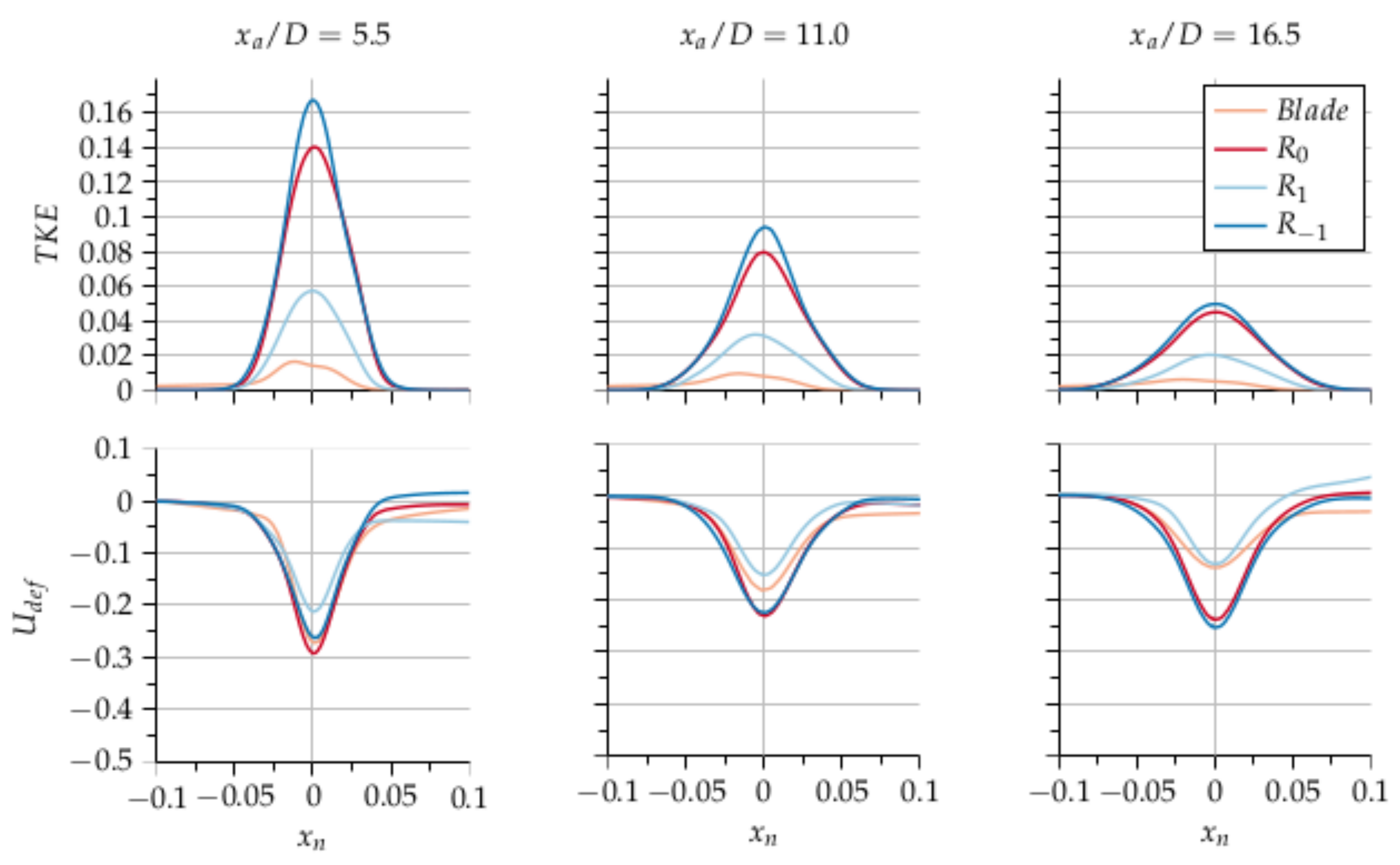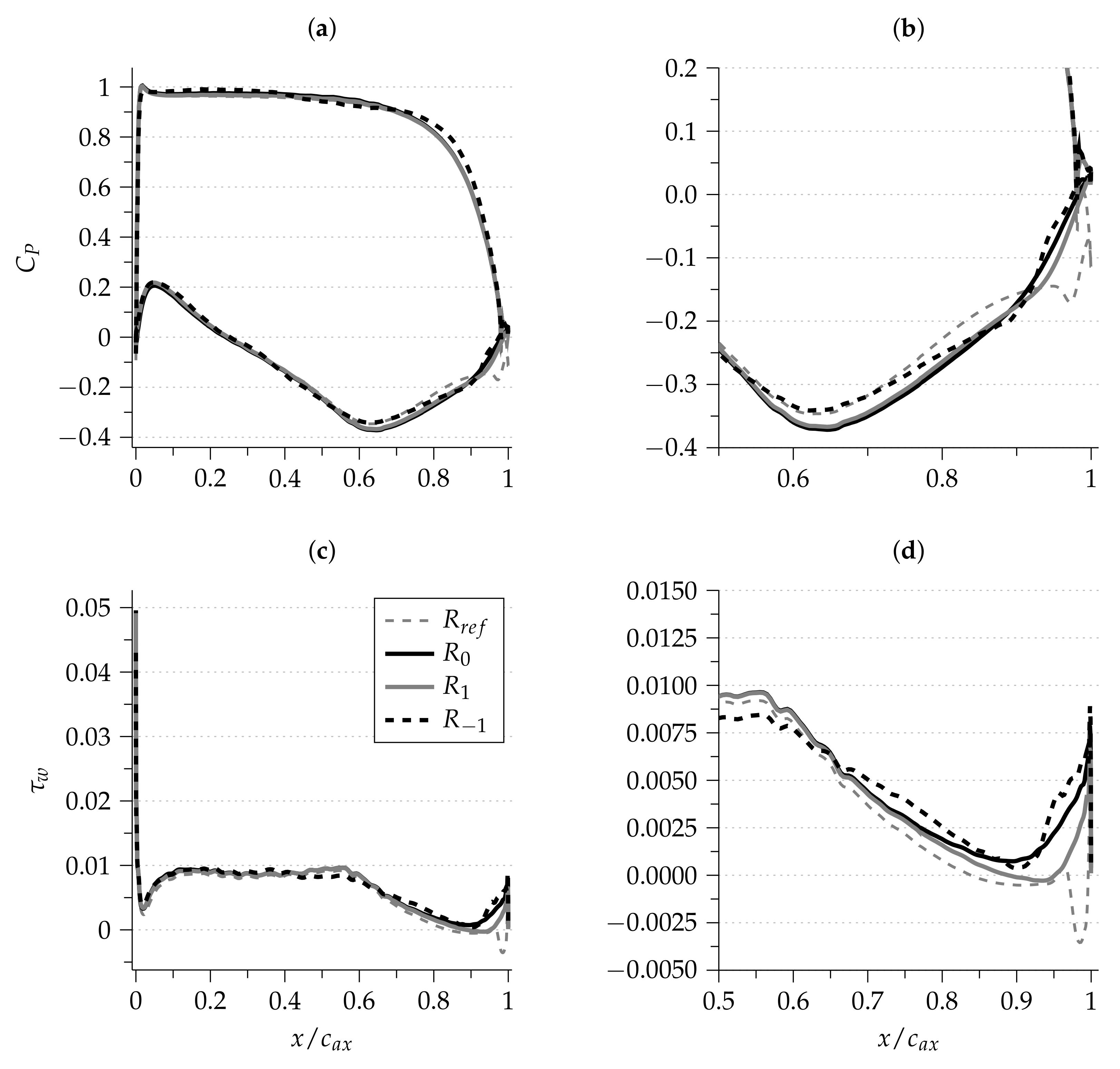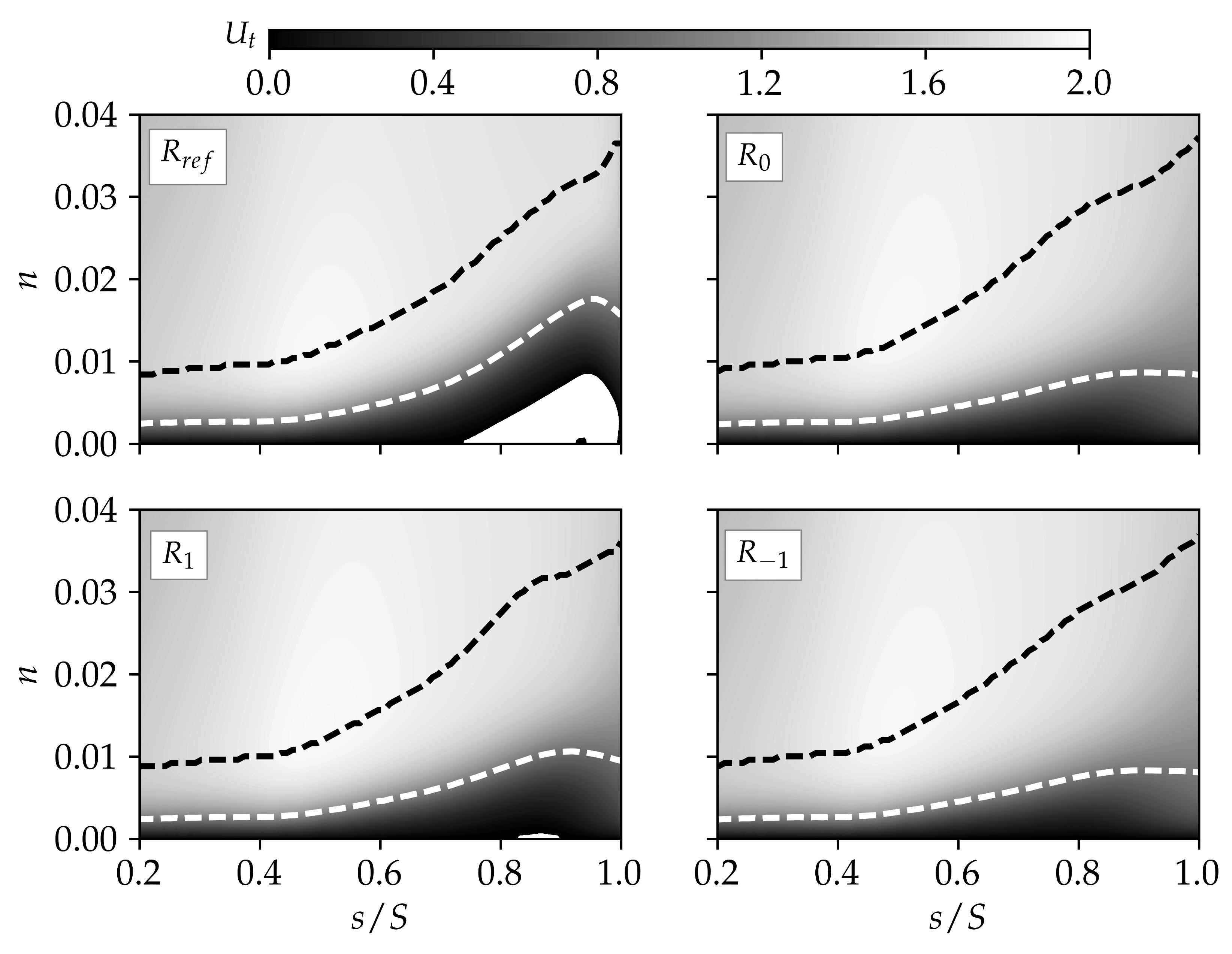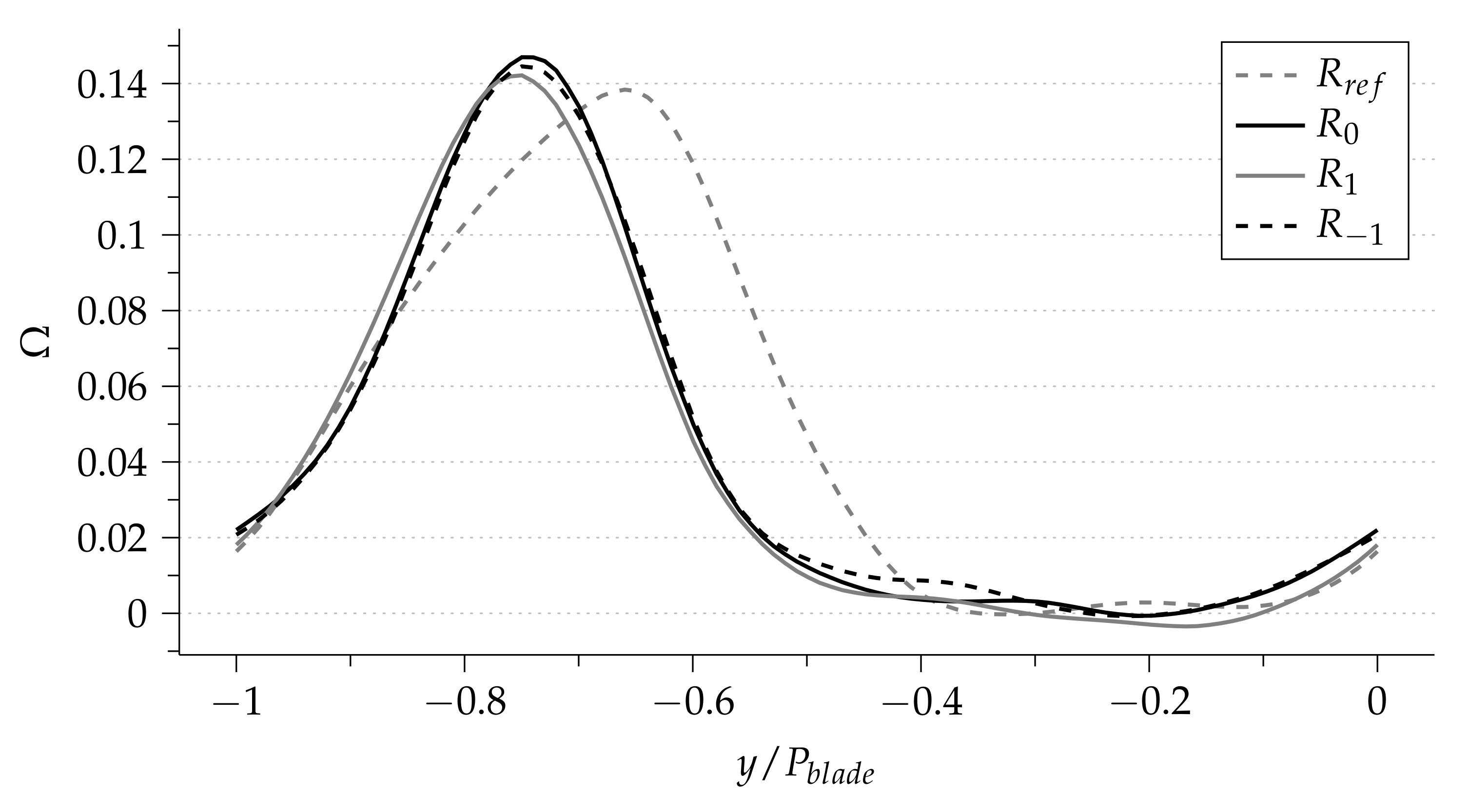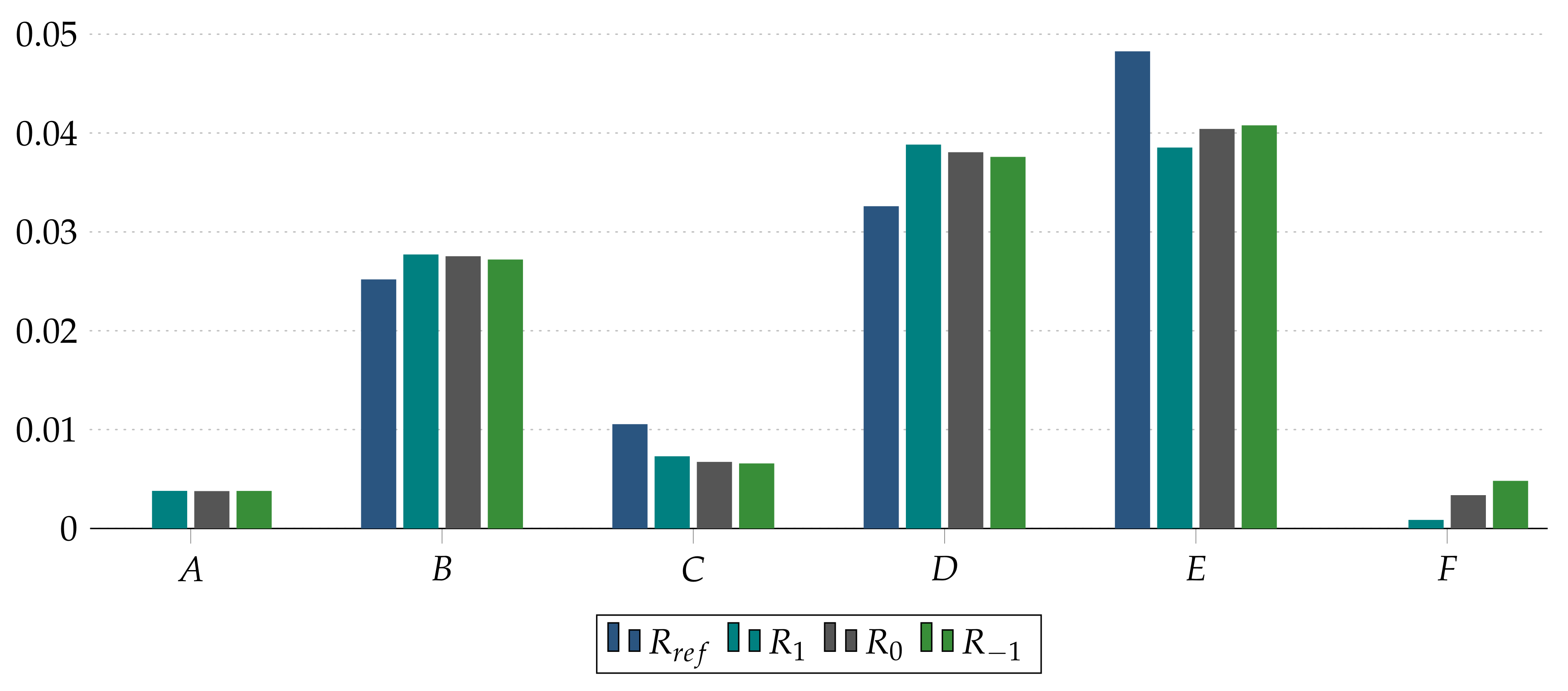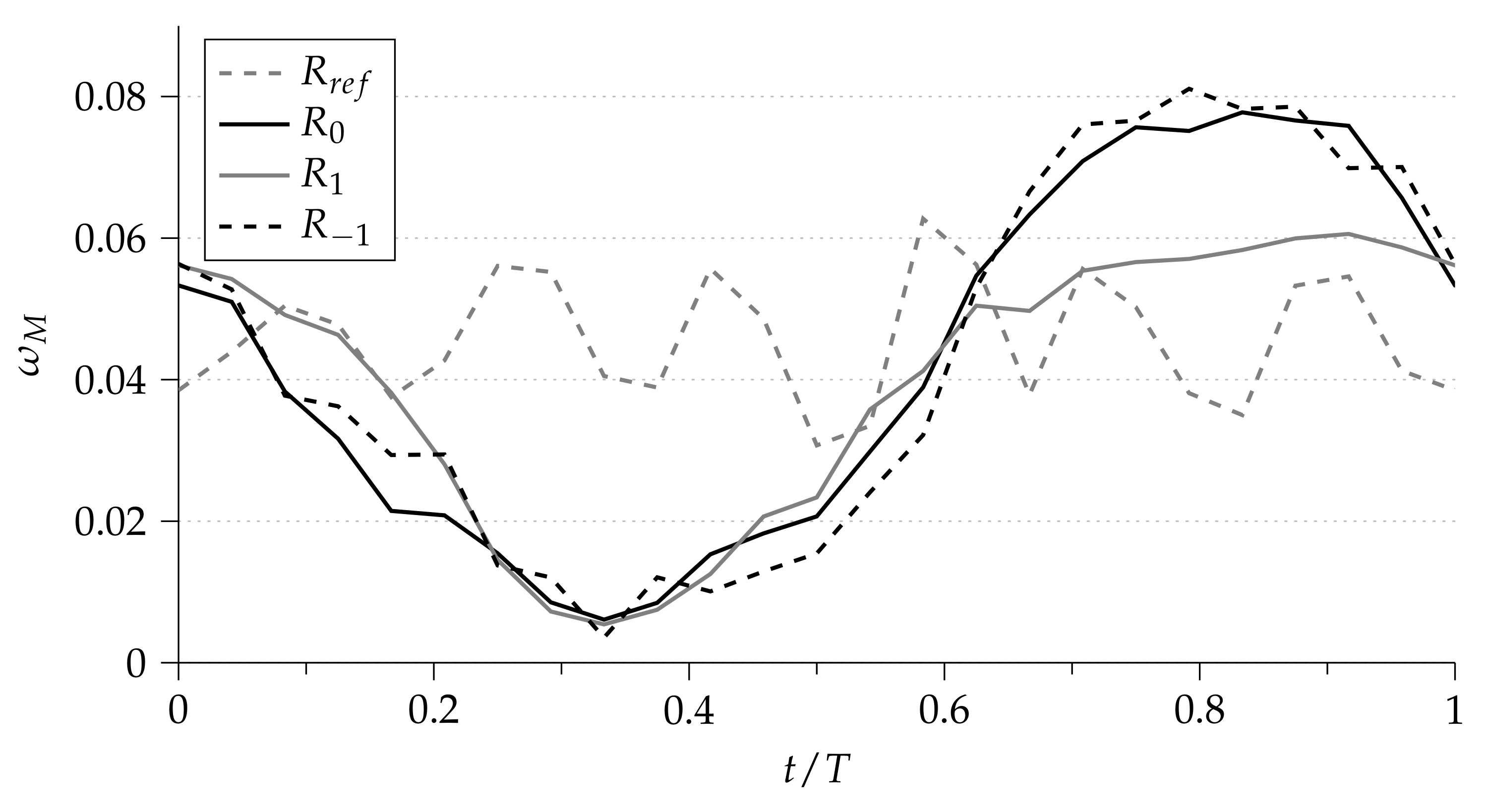Both time and phase-locked averaged statistics were gathered in order to investigate the flow field. All simulations were restarted based on an initial simulation and then run for more than 15 non-dimensional time units in order to go past the transient. One non-dimensional time unit, t, corresponds to the time it takes for the flow with unit velocity to convect over one chord length, c. After that, data over another 16 non-dimensional time units were collected for the averaged statistics. The periodicity in the spanwise direction allowed for a spatial averaging in this direction while the simulation was running, reducing the costs for I/O. Lastly, the already spatially averaged data were then averaged over time.
In the following, the results are divided into two parts. Firstly, the different bar wake profiles are investigated and compared to an actual blade wake. Secondly, the implications of the different wakes on the blade profile and the turbine losses are presented.
3.1. Wake Results
The differences between the bar wakes and the actual blade wake are first shown by means of time-averaged statistics. In order to do so, wake profile data perpendicular to the wake centre lines at three different positions , and , based on the bar diameter D, downstream of the bars and blade were extracted. The centre lines were determined by the peak velocity deficit locations in the wakes.
The turbulent kinetic energy,
(top) and the velocity deficit,
(bottom) profiles for the three different positions are shown in
Figure 2. These quantities were normalised by
and
, respectively, with the local velocity,
obtained outside of the wakes. A fairly rapid mixing of all the wakes, indicated by the decreasing
and widening of the profiles while moving downstream, is evident. The clockwise rotating bars generate wakes with the highest levels of turbulent kinetic energy, followed by the stationary bar case. Slightly skewed and much weaker wake profiles are achieved by the counter-clockwise rotating bars, which are more similar in shape to an actual blade wake. However, the turbulent kinetic energy is a factor of three higher. The fact that the bars generate much higher levels of turbulent kinetic energy is in agreement with the experimental findings of Halstead et al. [
8] (p. 442).
The velocity deficits of the bar wake profiles, aligned at point , for the cases and are quite similar for all three downstream positions. In the case, the amplitude of the velocity deficit is markedly lower and decays in a similar manner to the blade wake. Interestingly, the profiles of the bar wakes compare better to the blade wake profiles, as opposed to the profiles.
Owing to the different rotation rates of the upstream bars, the flow turning is changed, altering the angle of attack
, obtained at Measurement Position 1. However, it is important to maintain the angle of attack,
for the blade constant for all the cases in order to be able to attribute the effects on the turbine caused by the different wakes only. By changing the pitch-wise flow velocity,
, at the inlet plane and keeping the streamwise component,
, unaltered, which would influence the mass flow rate and the flow coefficient (Equation (
1)) otherwise, the flow turning can be compensated.
Table 2 shows the flow correction angle
that was needed in order to compensate the flow turning and establish a constant angle of attack
. This also ensured that the same turbine conditions, determined by the isentropic Reynolds,
and Mach numbers,
, could be achieved. Hence, the differences shown in the Results Section can be solely attributed to the different bar wake properties. As can be seen, the correction only has a small effect on the bar Reynolds number,
.
Furthermore, the drag,
, and lift,
, coefficients parallel and perpendicular to the flow direction, respectively, are given. Owing to the Magnus effect, different values were obtained, which allows one to check whether the drag coefficient is a reliable parameter as a design criterion for bars, as stated by Pfeil and Eifler [
27]. The mixed out losses,
(see Equation (
6) for definition), behind the bars (
) show a strong correlation with the drag coefficients.
Phase-locked averaged results enable the tracking of the wakes passing through the cascade at different time instants. As already mentioned, one bar passing period was divided into 24 phases, which were averaged over a total of 16 periods.
The phase-lock averaged turbulent kinetic energy,
, for the three different bar wakes at two different phases is shown in
Figure 3. As can be seen, the wakes of the cases
(a,d) and
(c,f) passing through the turbine passage are much more pronounced than the wake of case
(b,e). The typical wake distortion, as described by Smith [
28], and an increase in turbulent kinetic energy in the passing wake close to the suction surface, as observed by other authors [
29,
30], were apparent for all cases. Furthermore, the levels of
of the blade wakes are substantially higher compared to the bar wakes, but finally merge with them further downstream.
3.2. Implications for the Turbine Cascade
The state of the blade wakes is dependent on the state of the boundary layers, which in turn are influenced by the bar wakes passing through the blade passage. A mutual dependence between the bar wakes and the blade wakes is the result, which will be investigated more deeply in the following sections. In order to do so, firstly, the influence of the bar wakes on the blade itself is presented. After that, the combined effects of the merged blade and bar wakes in terms of loss quantification are examined.
Time-averaged plots of the pressure coefficient
over the whole blade surface and the wall shear stress
on the suction surface are shown in
Figure 4a,c. For all cases, there are virtually no differences in
for most of the blade surface. The portion most affected by the bar wakes is restricted to the aft region of the suction surface of the blade. The strongest wakes, case
, slightly increase the pressure on both the suction and the pressure surface compared to the other cases. A separation bubble for the
case, which starts at around
and reattaches near
, can be observed (
Figure 4b,d). The reference case
shows a marked difference from
up to the trailing edge, indicating an even larger separation bubble.
The wall shear stress, , on the suction surface is identical for cases and up to . After that point, drops for and goes below zero, but then rapidly recovers. The wall shear stress for the case drops at around and then increases at , yielding the highest values. These differences correlate with the strength of the bar wakes, where the strongest wakes produce the highest due to the mixing with the turbulent boundary layer in the aft portion, whereas the weakest wakes are not able to prevent the separation bubble. Furthermore, the wall shear stress level for the reference case is marginally lower from the leading edge up to . Towards the trailing edge, is significantly lower compared to the cases with bars, leading to a large separation bubble. This large separation bubble decreases the peak velocity on the blade and hence results in the mentioned reduction of before . The latter bubble, indicated by a sharp dip in wall shear stress, closes again at the trailing edge. The kink in the and slopes is caused by an additional small separation region behind the trailing edge.
Figure 5 shows the velocity contours, the edge of the boundary layer (black dashed) and the displacement thickness,
(white dashed), on the suction surface of the turbine blade. For that, the tangential flow velocity
was extracted as a function of the wall normal direction. Due to the pronounced wake regions in the boundary layer profiles, the first derivative of the tangential velocity in the wall normal direction,
, was used to determine the boundary layer edge. The position where the derivative is minimal
or crosses a given value
denotes the edge of the boundary layer.
The most striking feature that can be observed is the length of the separation bubble for the reference case and its wall-normal extension into the blade passage. The boundary layer remains laminar until the top of the bubble, then transitions and closes the separation shortly before the trailing edge. The cases and show very similar contours. A small separation bubble for case can be observed, as well. The most apparent differences can be observed in the thickening of the displacement thickness for cases and due to the separation bubbles.
Phase-locked averaged data are used in order to further investigate the effects on the cascade blade. A space-time diagram of the wall shear stress on the suction surface along the blade surface
s, normalised by the total suction surface length
S, for three bar passing periods
is shown in
Figure 6. Additionally, the time-averaged free stream velocities are plotted on top of the contours, where the peak velocity is aligned with the peak
spot at around
. The white spots denote wall shear stress levels below zero, i.e., flow separation. Qualitatively, the cases with bars are fairly similar for the majority of the blade, as already observed for the time-averaged results. The wall shear stress levels on the mid-chord, where the wakes hit the blade surface, seem to be slightly lower for case
. This is consistent with the experimental results of Halstead et al. [
8], who found increasing levels of wall shear stress for stronger wakes impinging on the blade. However, as already observed in
Figure 4, the wakes in case
cause slightly lower stress levels compared to case
in the mid-chord region.
Looking at the aft section of the blade, a large separation bubble for most of the time period can be observed for
. The size, the start and end point, as well as the duration of the bubbles markedly vary over the bar passing periods. At some time instants, two distinct separation bubbles occur. In the case of
, the size and the duration of the bubbles are substantially reduced. For case
, the separation bubbles are almost completely suppressed. Owing to the absence of incoming wakes, the reference case
does not show much variation over time, although there is clearly unsteadiness. Looking at a highly resolved time signal close to the bubble, the frequency and period of this unsteadiness could be calculated, yielding
and
, respectively. The values correspond to the vortex shedding frequency at the trailing edge and do not necessarily correlate with the frequencies of the instabilities that eventually lead to transition, as was also found by Wheeler et al. [
31], although for a high-pressure turbine blade.
The reason for the larger separation bubble for case
can be explained by looking at the incoming wakes passing through the blade passage; see
Figure 3. Due to the sensitivity of the separated flow to inflow disturbances, like incoming wakes, the weaker wakes of the
case seem to be less effective at reducing the size of the bubble, whereas the wakes for case
, which have the highest
levels, are most effective. As can be seen, this results in larger calmed regions, yielding a reduced separation bubble. This is also consistent with the experimental results of Halstead et al. [
8] and the simulation results of Sarkar [
32].
As the size of the separation bubble is related to the loss generation [
10], the largest loss values are to be expected from the reference case
, whereas the resulting loss values for the bar cases depend on both the incoming wakes and the size of the separation bubble. Furthermore, time varying losses for all cases should be linked to unsteadiness, which was even observed for the case without bars.
The losses in a low-pressure turbine cascade can be quantified by the total pressure loss
, where
is the mass averaged total pressure calculated at ‘Measurement Plane 1’,
is the mass averaged static pressure at ‘Measurement Plane 2’ and
is the total pressure profile at ‘Measurement Plane 2’. Loss profiles for all cases are shown in
Figure 7. The profile peaks, denoting the total pressure loss due to the blade wake, of
and
are very similar. The slightly lower peak loss value might be explained by the smaller separation bubble, only observed in the phase-lock averaging, for case
. For the bar case with the largest separation bubble,
, the peak loss value is the lowest, and the blade wake is slightly shifted, as well. The lowest peak loss, however, can be observed for the reference case without incoming bars. A significant deflection and widening of the blade wake is the result of the large separation bubble.
The losses in the region of the profile away from the peak values can be attributed to the passing wakes or rather to the losses generated in the turbine passage. At around
, the losses are most elevated for case
with the clockwise rotating bars, which produced the most pronounced wakes and hence had the strongest wake distortion. For case
, with the weakest incoming bar wakes, the smallest amount of pressure loss in the blade passage can be seen. The negative loss between
is due to varying inlet values in the pitch-wise direction caused by the bars [
33].
Denton [
34] identified three sources accounting for the overall profile loss, which will be referred to as Denton loss
(
D) in the following;
The first term of the right-hand side is the base pressure loss (
A) consisting of the base pressure coefficient
and the displacement thickness,
, at the trailing edge with thickness
. The losses due to the momentum and the displacement thickness at the trailing edge are given by the second (
B) and the third (
C) term, respectively. Another value to quantify losses in turbines is the mixed-out loss (
E) [
35], defined by:
see
Figure 1 identifying Measurement Planes 1 and 2. Rather than mass averaging, the flow variables are irreversibly mixed out to a state of complete equilibrium. The Indices 1 and 2 denote Measurement Planes 1 and 2 in
Figure 1, respectively. The Denton losses (
) and their respective terms, the overall mixed-out losses (
E) and the wake distortion losses (
F), where only the part of the profile outside the blade boundary layer is taken into account, are shown in
Figure 8. For the latter, only values less than roughly
of the peak total pressure loss of the respective profile were considered.
There are no apparent differences in the base pressure losses, A, for the three bar cases. The same observation can be made for the losses due to the momentum thickness, B. Owing to the larger separation bubble and hence a larger displacement thickness for case , the displacement loss, C, due to blockage effects, is increased, leading to a higher overall Denton loss, D, compared to the other cases. For the reference case, a negative base pressure was obtained due to a small second separation region behind the trailing edge. Furthermore, the momentum loss is lower compared to the bar cases. The very large separation bubble causes a marked increase for the displacement loss; however, a significantly lower overall Denton loss is achieved.
The highest mixed out loss,
E, is produced in the reference case
, as was already expected due to the large separation bubble. The bar case
, which led to the largest bubble, generated the lowest loss, whereas for case
with the almost non-existent separation bubble, the highest loss out of the three bar cases is obtained. Another reason for this can be found by looking at the wake distortion losses
F. As can be seen, the wakes with the lowest
levels, as well as the lowest drag coefficient and mixed out loss (
Table 2, in case
) also produce the least loss as opposed to the case with the most pronounced wakes,
. The
production term, defined by:
explains this behaviour, as already pointed out by Stieger and Hodson [
30]. The higher the turbulent stresses
, as is the case for
, the higher the production of turbulent kinetic energy and hence an increase in wake distortion losses. A comparison between the Denton losses,
D, and the mixed out losses,
E, in combination with the wake distortion losses,
F, reveals the importance of wake mixing effects. The Denton loss decreases for decreasing sizes of the separation bubble, but due to the stronger wakes, which in turn are responsible for the shrinkage of the separated region, the overall losses increase. Here, the reference case represents a special case, where due to the strong widening of the blade wake, the highest overall mixed out loss is achieved, but the lowest profile loss.
The phase-lock averaged mixed-out losses for one bar passing period are presented in
Figure 9. A distinct minimum and maximum peak loss for all bar cases are evident. Furthermore, all bar cases reach a similar minimum loss at around
. Considering the
contours in
Figure 3a–c (the black dashed line denotes the loss accounting plane) and the space-time diagram (
Figure 6) for
, it is clear that the minimum loss occurs at the time without a separation bubble on the blades and when the bar wake has not mixed with the blade wake yet. The opposite effect can be seen from
onwards, where a separation bubble occurs, for all cases, and the bar wakes mix with the blade wake. Lower losses are generated in the
case, whereas cases
and
reach a similar maximum loss. The deviation between the cases from
to
can be attributed to the influence of the larger separation bubble in the
bar case. This again demonstrates that the absence or reduction of a separation bubble in a low-pressure turbine does not necessarily lead to reduced overall losses, since wake distortion and the combined effects play an important role.
As already expected from the space-time diagram in
Figure 6, the reference case shows an unsteady loss behaviour, as well, with a period related to the vortex shedding frequency of the blade, but has a smaller amplitude due to the absence of the bar wakes. Hence, in this case, the time varying mixed-out losses can be solely attributed to the large separation bubble and the vortex shedding at the trailing edge.
In conclusion, the interaction between the weaker incoming wakes in case
and the blade wake leads to considerably lower overall and maximum losses, even though a much larger separation bubble is present, leading to higher profile losses. The consideration of the
levels is important when choosing wake-generating bars in the design process. This can be realised by using rotating bars and changing the drag coefficient, as already stated by Pfeil and Eifler [
27]; it has been proven to be a viable alternative to using different bar diameters. The very different lift coefficients did not contribute to any observable effect in our simulations.
As mentioned, the reduced frequency was chosen such that distinct wakes enter the blade passage. For higher reduced frequencies, the strength of the wakes might no longer be as important, as wake mixing occurs before the blade’s leading edge [
11]. Moreover, added inlet turbulence and higher Reynolds numbers can positively affect the losses [
6], and hence, the importance of the wake strength might change, as well. Coull et al. [
36] have shown that for higher Reynolds numbers, the wakes dominate the profile loss generation due to the increase of the momentum thickness of the turbulent boundary layer.

